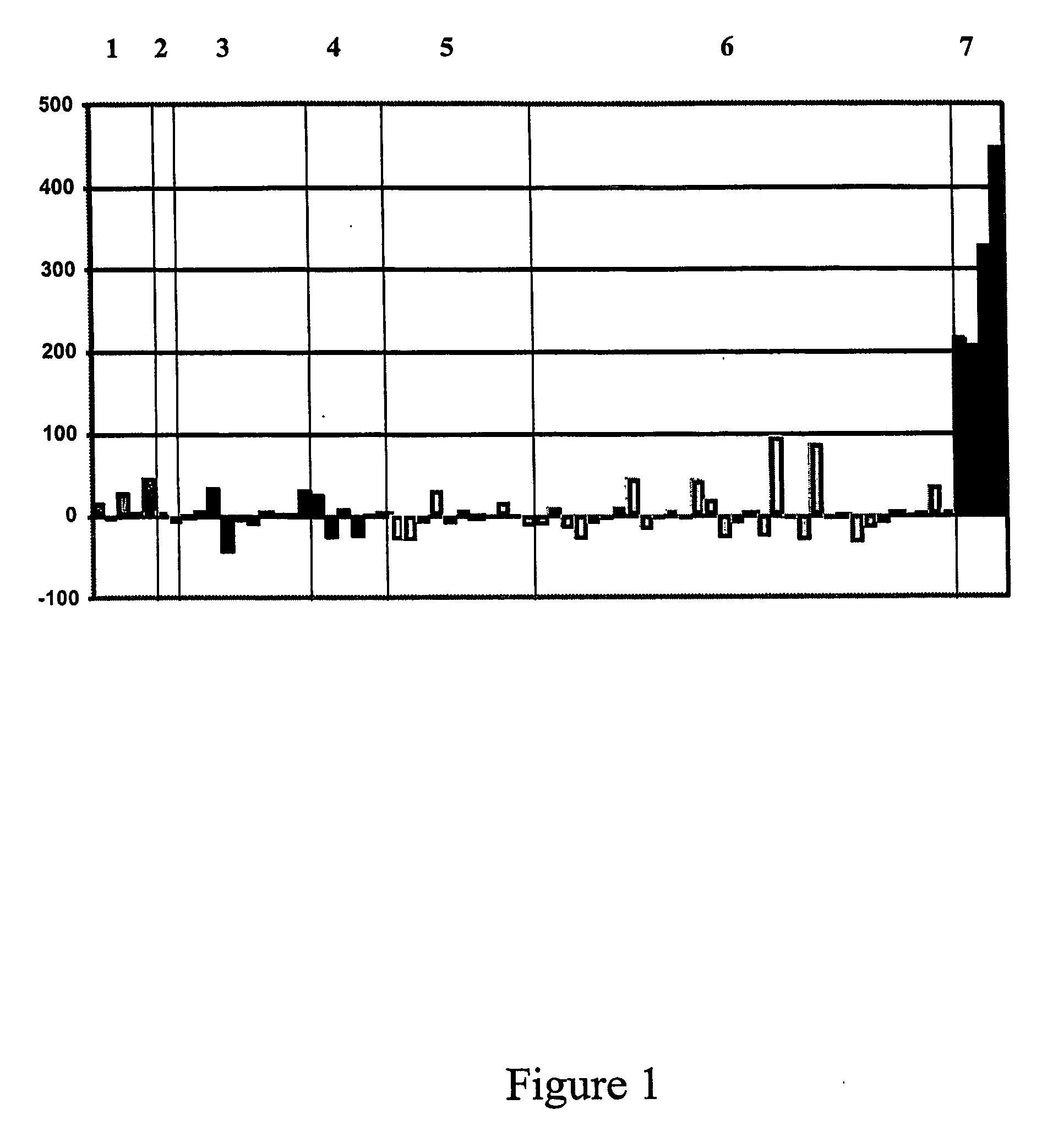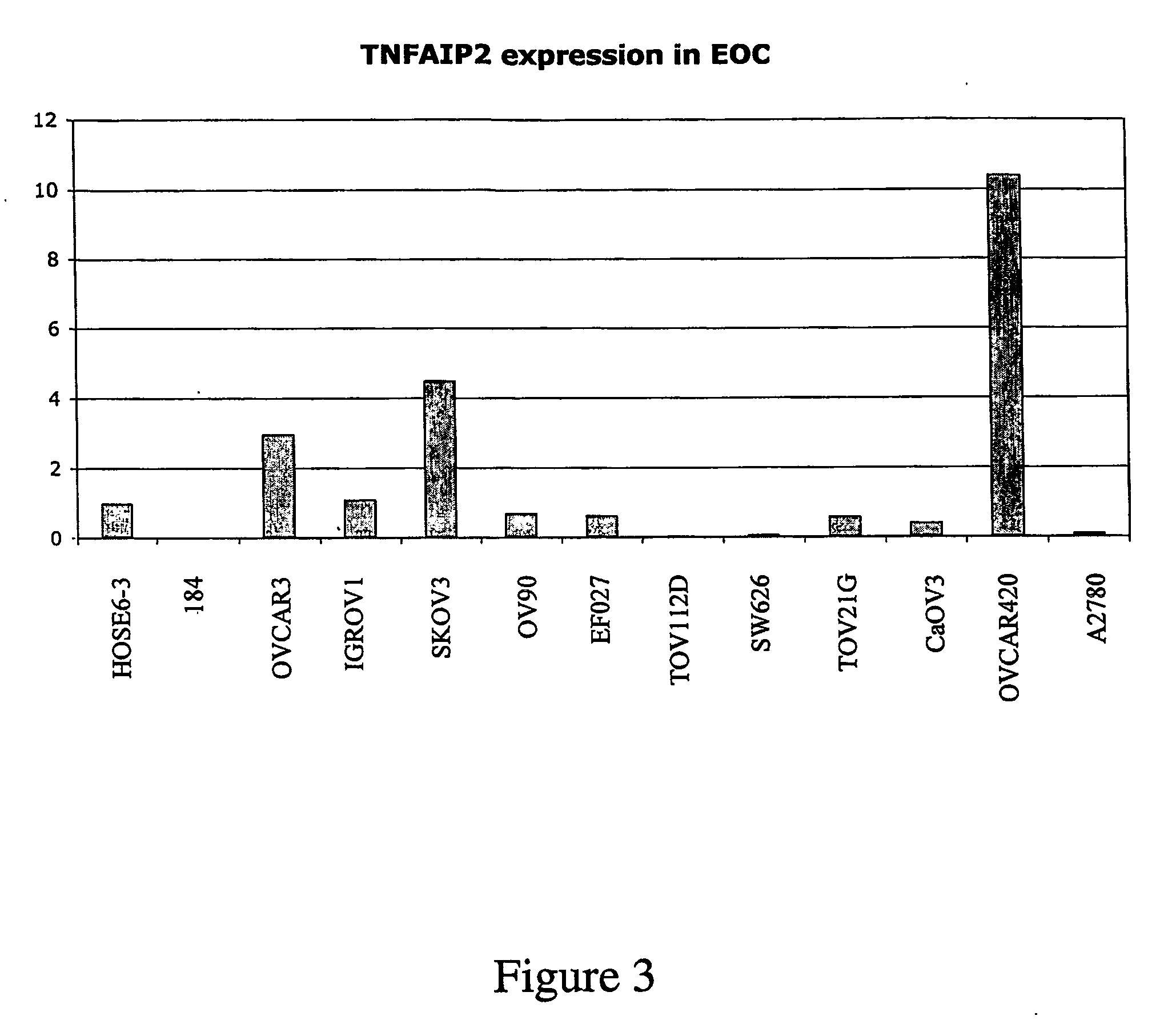Methods of diagnosis and prognosis of ovarian cancer II
a technology of ovarian cancer and prognosis, applied in the field of nucleic acid and protein expression profiles and nucleic acids, can solve the problems that the diagnosis of ovarian cancer is generally only possible, and achieve the effects of enhancing and reducing the activity or expression of the polypeptid
- Summary
- Abstract
- Description
- Claims
- Application Information
AI Technical Summary
Benefits of technology
Problems solved by technology
Method used
Image
Examples
example 1
Gene Expression Profiling to Identify Differentially-Expressed Genes in Ovarian Cancer
[0536] Tissue was collected from patients undergoing treatment at the GCC, we have established an Ovarian Cancer Tissue Bank and Clinical Database that currently holds data on over 400 cases treated at the GCC between 1986 and 2002. Tissue (currently 149 fresh / frozen and 292 archival fixed paraffin-embedded samples) was acquired from patients undergoing cytoreductive surgery and does not interfere with the collection of tissue for the normal processing of diagnostic specimens. Patient consent, included in all our studies, was collected prior to surgery. Tissue specimens and their associated pathology reports were coded in order to maintain patient confidentiality. Uncoded data was electronically and / or physically locked with restricted access by appropriate senior investigators only. Clinical (diagnosis, treatment, residual disease) and pathological data (tumour grade,...
example 2
Validation of Gene Expression Profiling Results Using Tissue Microarrays
[0546] Each of the transcripts identified as being differentially-expressed specifically in ovarian cancer was then further analysed using in situ hybridization or immunohistochemical staining of tissue microarrays constructed from a large cohort of primary ovarian tumor tissue. Such analysis confirms upregulation, down-regulation or total loss of expression of the transcripts identified in the microarray analysis of tumor samples.
[0547] By way of example, in situ hybridization data presented in FIGS. 2A-2G indicate reduced expression of KIAA1983 in ovarian cancers relative to normal ovarian tissues, such that, for example, expression is only detectable in the basal membrane surface of inclusion cysts and notin serous, mucinous or endometroid ovarian cancer tissues.
[0548] Furthermore, as each of the samples in the tissue microarray have been clinicopathologically characterized (for example to identify cancer ...
example 3
Identification of Prognostic Markers of Ovarian Cancer
[0552] Using a classical survival analysis to mine expression profiling data several genes that are associated with poor patient outcome (ie death or cancer relapse) have been, identified (Table 4). Such genes have clinical utility as prognostic indicators of disease.
[0553] Using detailed clinicopathological and postoperative data on all of the 51 patients included in our transcriptional profiling studies, including details of biochemical (eg. rising serum CA-125) and / or clinical recurrence of disease and overall survival, expression profiles were correlates with clinical parameters.
[0554] A survival analysis is performed on the 33 serous cancers within this cohort. The median follow-up time for these patients was 25.5 months from the date of primary laparotomy to the date of last follow-up or the date of death, and 21 of these patients (66%) were deceased from causes related to their malignancy.
[0555] Analysis of the express...
PUM
| Property | Measurement | Unit |
|---|---|---|
| Fraction | aaaaa | aaaaa |
| Fraction | aaaaa | aaaaa |
Abstract
Description
Claims
Application Information
 Login to View More
Login to View More - R&D
- Intellectual Property
- Life Sciences
- Materials
- Tech Scout
- Unparalleled Data Quality
- Higher Quality Content
- 60% Fewer Hallucinations
Browse by: Latest US Patents, China's latest patents, Technical Efficacy Thesaurus, Application Domain, Technology Topic, Popular Technical Reports.
© 2025 PatSnap. All rights reserved.Legal|Privacy policy|Modern Slavery Act Transparency Statement|Sitemap|About US| Contact US: help@patsnap.com



